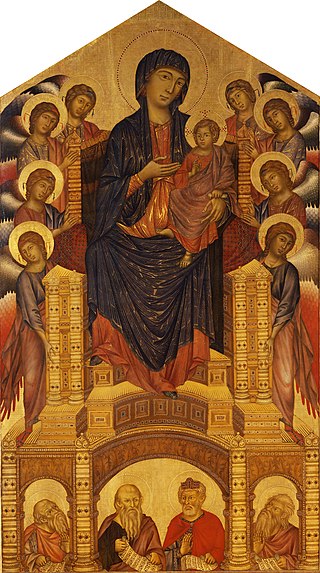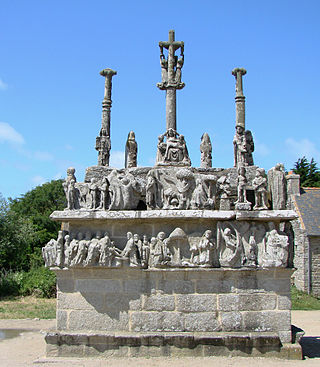
Cimabue, also known as Cenni di Pepo or Cenni di Pepi, was an Italian painter and designer of mosaics from Florence.

Lorenzo Ghiberti, born Lorenzo di Bartolo, was an Italian Renaissance sculptor from Florence, a key figure in the Early Renaissance, best known as the creator of two sets of bronze doors of the Florence Baptistery, the later one called by Michelangelo the Gates of Paradise. Trained as a goldsmith and sculptor, he established an important workshop for sculpture in metal. His book of Commentarii contains important writing on art, as well as what may be the earliest surviving autobiography by any artist.

Pietro Lorenzetti or Pietro Laurati was an Italian painter, active between c. 1306 and 1345. Together with his younger brother Ambrogio, he introduced naturalism into Sienese art. In their artistry and experiments with three-dimensional and spatial arrangements, the brothers foreshadowed the art of the Renaissance.

The Wilton Diptych is a small portable diptych of two hinged panels, painted on both sides, now in the National Gallery, London. It is an extremely rare survival of a late medieval religious panel painting from England. The diptych was painted for King Richard II of England, who is depicted kneeling before the Virgin and Child in what is known as a donor portrait. He is presented to them by the English saints King Edmund the Martyr, King Edward the Confessor and patron saint, John the Baptist. The painting is an outstanding example of the International Gothic style, and the nationality of the unknown artist is probably French or English.

The Virgin of the Rocks, sometimes the Madonna of the Rocks, is the name of two paintings by the Italian Renaissance artist Leonardo da Vinci, of the same subject, with a composition which is identical except for several significant details. The version generally considered the prime version, the earlier of the two, is unrestored and hangs in the Louvre in Paris. The other, which was restored between 2008 and 2010, hangs in the National Gallery, London. The works are often known as the Louvre Virgin of the Rocks and London Virgin of the Rocks respectively. The paintings are both nearly 2 metres high and are painted in oils. Both were originally painted on wooden panels, but the Louvre version has been transferred to canvas.

The Basilica of Saint Francis of Assisi is the mother church of the Roman Catholic Order of Friars Minor Conventual in Assisi, a town in the Umbria region in central Italy, where Saint Francis was born and died. It is a Papal minor basilica and one of the most important places of Christian pilgrimage in Italy. With its accompanying friary, Sacro Convento, the basilica is a distinctive landmark to those approaching Assisi. It has been a UNESCO World Heritage Site since 2000.

The Portinari Altarpiece or Portinari Triptych is an oil-on-wood triptych painting by the Flemish painter Hugo van der Goes, commissioned by Tommaso Portinari, representing the Adoration of the Shepherds. It measures 253 x 304 cm, and is now in the Galleria degli Uffizi in Florence, Italy. This altarpiece is filled with figures and religious symbols. Of all the late-fifteenth-century Flemish artworks, this painting is said to be the most studied.

Florentine painting or the Florentine School refers to artists in, from, or influenced by the naturalistic style developed in Florence in the 14th century, largely through the efforts of Giotto di Bondone, and in the 15th century the leading school of Western painting. Some of the best known painters of the earlier Florentine School are Fra Angelico, Botticelli, Filippo Lippi, the Ghirlandaio family, Masolino, and Masaccio.

This article about the development of themes in Italian Renaissance painting is an extension to the article Italian Renaissance painting, for which it provides additional pictures with commentary. The works encompassed are from Giotto in the early 14th century to Michelangelo's Last Judgement of the 1530s.

Giotto di Bondone, known mononymously as Giotto and Latinised as Giottus, was an Italian painter and architect from Florence during the Late Middle Ages. He worked during the Gothic/Proto-Renaissance period. Giotto's contemporary, the banker and chronicler Giovanni Villani, wrote that Giotto was "the most sovereign master of painting in his time, who drew all his figures and their postures according to nature" and of his publicly recognized "talent and excellence". Giorgio Vasari described Giotto as making a decisive break with the prevalent Byzantine style and as initiating "the great art of painting as we know it today, introducing the technique of drawing accurately from life, which had been neglected for more than two hundred years".

The Santa Trinita Maestà is a panel painting by the Italian medieval artist Cimabue, dating to c. 1290-1300. Originally painted for the church of Santa Trinita, Florence, where it remained until 1471, it is now housed in the Uffizi Gallery of Florence, Italy. It represents the Madonna enthroned with the Baby Jesus and surrounded by eight angels and, below, four half portraits of prophets.

The Master of the Legend of Saint Catherine is the notname for an unknown late 15th century Early Netherlandish painter. He was named after a painting with Scenes from the Legend of Saint Catherine, now kept in the Royal Museums of Fine Arts of Belgium. He was active between c. 1470 and c. 1500, probably around Brussels.

The Calvary at Kergrist-Moëlou in the Arrondissement of Guingamp in Brittany, France, dates back to 1578. It was the work of the sculptor Guillaume Jézéquel except for the crucifix which was the work of the sculptor Yves Hernot de Lannion and was remounted on the calvary in 1896. Kergrist-Moëlou is located in the Côtes-d'Armor region, the ancient diocese of Cornouaille. Jézéquel had worked alongside his brother on the Kergrist-Moëlou church in 1554. Originally the calvary's sculpture was substantial, with records showing that it was decorated with almost one hundred statues telling the story of the life and death of Jesus Christ, but the calvary was vandalized during the 1793 French Revolution leaving many statues broken and decapitated with others disappearing completely. What is now left of the calvary stands on a large octagonal granite base and fragments of the mutilated figures are placed around the cross itself. This article gives some of the history of the calvary and describes its constituent parts.

Calvary at Tronoën is a calvary located at Saint-Jean-Trolimon in the Quimper arrondissement. It is located in the "pays bigouden", a particularly wind swept area of Brittany; the nearby chapelle was called the "cathédrale des dunes".

The Bladelin Altarpiece, or Middelburg Altarpiece, is a triptych painting created around 1450 by the Flemish painter Rogier van der Weyden, towards the end of his artistic career. It depicts scenes relating to the birth of Jesus; and as the only nativity scene definitively attributed to van der Weyden is sometimes known as the Nativity Triptych.

Christ Mocked is a small 13th-century panel painting by the Italian artist Cimabue, in tempera on a poplar panel. It depicts the Mocking of Jesus and is one of three panels known from a polyptych depicting the passion of Jesus. It was discovered in the kitchen of an elderly woman in Northern France. In October 2019 it sold at auction for €24 million, a record for a pre-1500 artwork. It is believed to be the first work by Cimabue to have been auctioned.

Virgin and Child with Two Angels is a panel painting by 13th-century Italian artist Cimabue, in egg tempera on a poplar panel, dated to c. 1280. It has been held by the National Gallery in London since 2000.

The Flagellation of Christ is a panel painting by 13th-century Italian artist Cimabue, in egg tempera and gold leaf on a poplar panel, dated to c.1280. It has been held by the Frick Collection in New York since 1950, and is the only painting by Cimabue in the US. The Frick Collection acquired the painting from the Knoedler gallery in Paris in 1950. Previously, it had been owned by the antiques dealer M Rolla at the end of the 19th century, inherited by G Rolla, and then sold to the art dealer Eduardo Moratilla.

The Mosaic ceiling of the Florence Baptistery is a set of mosaics covering the internal dome and apses of the Baptistery of Florence. It is one of the most important cycles of medieval Italian mosaics, created between 1225 and around 1330 using designs by major Florentine painters such as Cimabue, Coppo di Marcovaldo, Meliore and the Master of the Magdalen, probably by mosaicists from Venice.



















